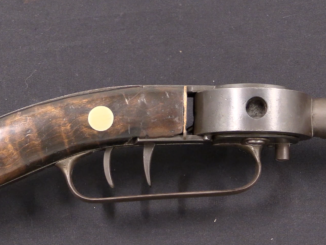Even the legendary Elmer Keith started out as a total newbie to shooting and reloading, and blew up a gun with wildly dangerous handloads in 1923. I got my hands on the remnants of the cylinder from that gun, and I think we can learn a couple important things from it…
Thanks to James D. Julia for giving me the chance to have a look at this cool artifact!




Not surprised at ALL! The .45 Colt was a black powder cartridge, and who knows what smokeless powder Keith was experimenting with, as well as a heavy bullet. Good news is he wasn’t injured!
BTW: So far I know after this experience Keith consider .45 Colt fire-arm as a “too weak” for developing more powerful, and switched too .44 Special (because the .44 and .45 were often produced with same size cylinder, the .44 would therefore have thicker walls) which later was developed into .44 Magnum.
The thicker walls applied too existing fire-arms but when considering new fire-arm .45 Colt also was used to create Magnum – i.e. .454 Casull.
He used a full case of King’s Semi-Smokeless over a soft 260 grain government bullet. Since Elmer says that it was a 260 grain bullet it most likely was a pulled or surplus government 45 Colt slug. The cases were said to be well worn and with stretched primer pockets. See GUNS and AMMO January 1969.
Did he get a reply?
I just watched the video on Elmer Keith’s ka-BOOM! It reminded me of my buddy Richie who had a Ruger .44 magnum SuperBlackhawk. He’d bought a pound of Alliant Bullseye from Karl Highbaugh’s gunshop. The powder was in bulk and he had Karl put it in his empty Alliant 2400 canister. Unfortunately Richie never relabled the canister. When he got to reloading he thought he was using 2400 powder in the loads! So what he really loaded up was a double charge of Bullseye! His son Paul was shooting the pistol and he noted that it kicked awfully hard on that first shot. When he brought the pistol back on target he noted that he no longer had a rear site! It was gone along with the top strap and the upper 3 chambers were all blown away! Fortunately no one was hurt! And we never did find the topstrap!
“topstrap”
So far I know, at least modern revolvers, are designed in way so if chamber would rupture it shouldn’t wound shooter, in your case topstrap proved to be weakest element and acts as steam boiler safety valve.
Mr. Keith, in an article he wrote for Guns and Ammo in January 1960 ( Elmer Keith picks his “Favorite” Loads for Handguns) records the load as a “full case” of King’s Semi-Smokeless over a 260 grain government soft lead bullet. The cases were described as well used with loose primer pockets. As to a current parallel of King’s Semi-Smokeless, I would defer to P. Sharpe’s Guide to Handloading.
Other sources indicate that the “modification” was substituting nitrocellulose for part of the KNO3 to 20% of the total mix. This would result in a fairly touchy double-base powder mix that would in fact be prone to detonation rather than a normal burning curve, especially as degradation over time resulted in the formation of esters.
In short, not a good choice for experimentation, especially not with over-bore-size bullets creating a sharp pressure spike as they entered the forcing cone.
cheers
eon
ERROR! The article was from January 1969.
In my younger days, back when the T Rexs roamed at liberty, my mantra was, “If some is good then more is better and too much is JUST RIGHT!” And following this protocol enabled me to blow primer pockets, weld cases into chambers and blow extractors clean off of formerly perfectly good rifles. Back then most reloading was by following the rule of starting somewhere north of where you thought you should be and work backwards. (Nobody ever accused us of being smart or we would not be reloading in the first place.) I never blew a cylinder but have seen several that this had happened to … usually from a “double-charge.” I finally came to the conclusion that in an intensive reload situation cylinder flutes were not desirable at all because they weakened the cylinder by a very minute measure. I have seen more than one Python with swelled or ruptured cylinders, “locked-up” cylinders and more than one rifle that the bolt had to be operated with the judicious application of a ball peen hammer often leaving the rear of the case in the chamber. This called for a case removal tool and often a swelled chamber. After several near-misses one learns to VERY carefully check what powder is being used, visually check the powder level in handgun cartridges and, as I finally chose to do, use a rifle powder that even with a completely full case cannot exceed the safe operational pressure of the action. As for bullet diameter, NEVER take for granted that the label represents the true diameter of the contents. Get an accurate micrometer and use it! Failure to do so can earn one a new nickname of “Lefty,” “Stump” or “Dearly Departed.”
Correction: “…leaving the rear of the case..” should have been “leaving the front of the case …” Sorry ’bout that.
My question is: How did he get to the THIRD shot before he realized he had a problem?
In the Guns and Ammo article Elmer states that 2 rounds went off simultaneously.
It is possible that the explosion of one caused a second to go off.
That was Elmer’s explanation. Almost as interesting was a round leaking off the loading gate of a SAA and embedding it in his hand. He never found the missing top start from the cylinder failure.. Interestingly, after the tale he emphasizes that black powder, “screw front” , Colt SAA should not be fired with greater than black powder loading. Elmer doesn’t say if the inadvertent disassembly was in a black powder weapon. But reading between the lines, it was very likely.
I noticed in the video that the remaining cartridge in the cylinder had a ‘balloon’ head. This would be a great opportunity to expand on that for the viewers without grey hair!
At least this accident was arguably better than having a Langenhan FL’s breech block retention screw loss somewhere in the trenches (which would result in the breech block flying out of the slide and into your face upon the next trigger pull).
Or a Ross rifle with the bolthead flipped the wrong way blowing out in your face.
I once found a sporting .280 Ross on the rack in a local pawn shop. The owner was a friend of mine, so when I told him the bolt was unlocked even when in battery (the bolt being 1/4″ back from the forwardmost position being the giveaway) he listened. He took it off the rack and it ended up with a collector who knew enough about the Ross straight-pull to not get killed by being behind it.
I’ll stick to Mausers, TYVM.
cheers
eon
King’s Semi-Smokeless powder is a modification of American Wood Powder. According to P. Sharpe it was patented 17 January 1899 as a mixture of 29% nitrated wood cellulose, 60% saltpeter, 12% charcoal, and 8% sulphur. Accordingly Sharpe emphasizes that it is extremely dangerous and may combust with shaking in a can. See P. Sharpe, COMPLETE GUIDE TO HANDLOADING.
Elmer also says that he moved away from the 45 Colt to the 44 Special because he had experienced many cases with ripped rims while reloading. Remember the rim of a 45 Colt is much smaller than the 44 Special. Elmer also thought that the 44 Special guns had tighter bore, cylinder, and forcing cone dimensions than the 44 Special. The extra steel in the cylinder I am certain did not hurt either.
Error. The 44 Special had tighter tolerances than the 45 Colt.
Keith’s books are great. I have read “SixGuns”, and “Hell, I was there” Besides great information about his life, there are stories about his being a hunting guide, especially to Hollywood types and other celebrities, mostly A.H.s
What’s really interesting is he describes Dick Cassul’s triplex load for 45 colt. It’s a real “don’t try this at home” load, and unnecessary, with modern magnum powders available to you and me, but not to these grand gentlemen back in the 50s.
UNFORGETTABLE ELMER .
GOD REST HIS SHOOTING SOUL .
Found Ian’s commentary that Elmer shot at everything to be funny in an understated sort of way. Some people scoff at the claims he made of long range shooting with revolvers, but then again, if one shoots at basically everything that flies or walks (on four legs) it helps the odds.
• Ian, watching you handle that cylinder… that’s like handling a piece of the True Cross for people like us.
• As I write this in 2020, July 4th marks the 95th anniversary of Elmer’s blowing up his sixgun. Mark your calendars, folks—the centenary is only five years away!
I stand corrected; I thought I read that Elmer blew up his gun in 1925.
“ruined the revolver” is not entirely accurate. In Sixguns, Kieth tells of having a new top strap welded on by J.D. O’Meara, marveling how he could do such fine work with only one hand.